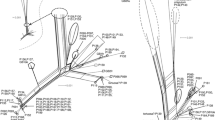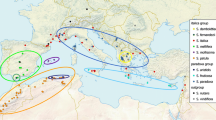Abstract
Icefree, terrestrial, Antarctic ecosystems have a polar desert-like appearance with a scarce vegetation cover, completely dominated by bryophytes and lichens. Knowledge of the rich Antarctic lichen biodiversity, including c. 400 species, is therefore necessary, also for studies of other ecosystem components. The genus Psoroma is partly dominant there, and own ongoing research indicates that many of its members have been misunderstood. The aim of the present study is to describe Psoroma antarcticum as new to science, study its habitat ecology and total distribution, and include a genetic analysis with respect to its internal variation and relationship to other species. The species differs from the closely related species Psoroma hypnorum, in having distinctly cup-shaped apothecia with thalline excipuli without squamules and tomentose lower sides, in having shorter ascospores without apical nodulose extensions and thalli with grey-to-black melanins. It is shown to form a monophyletic clade based on an analysis of the ITS, LSU, and mtSSU loci, and this clade is included in the Psoroma s. str. clade, which includes P. hypnorum, Psoroma paleaceum, Psoroma buchananii, and Psoroma fruticulosum with high statistical support. The new species has its main distribution in the maritime South Shetland and South Orkney Islands of Antarctica, and most samples originate from King George Island, where it is common and an important component in polar desert-like vegetation. Scattered occurrences have also been found in Chilean Tierra del Fuego, South Georgia, and Bouvet Island.



Similar content being viewed by others

References
Arntz WE, Thatje S, Linse K, Avila C, Ballesteros M, Barnes DKA, Cope T, Cristobo FJ, de Broyer C, Gutt J, Isla E, López-González P, Montiel A, Munilla T, Ramos Esplá AA, Raupach M, Rauschert M, Rodríguez E, Teixidó N (2006) Missing link in the Southern Ocean: sampling the marine benthic fauna of remote Bouvet Island. Polar Biol 29:83–96
Culberson CF (1972) Improved conditions and new data for identification of lichen products by standardized thin-layer chromatographic method. J Chromatogr 72:113–125
Ekman S, Wedin M, Lindblom L, Jørgensen PM (2014) Extended phylogeny and a revised generic classification of the Pannariaceae (Peltigerales, Ascomycota). Lichenologist 46:627–656
Elevebakk A (2012) An overlooked Psoroma in Denmark and southern parts of Sweden. Graphis Scr 24:45–48
Elvebakk A, Bjerke JW (2005) Pannaria isabellina (Vain.) comb. nov., a remarkable lichen species from Chile. Lichenologist 37:47–54
Elvebakk A, Galloway D (2003) Notes on the heterogeneous genus Psoroma s. lat. in New Zealand. Australas Lichenol 53:4–9
Elvebakk A, Robertsen EH, Park CH, Hong SG (2010) Psorophorus and Xanthopsoroma, two new genera for yellow-green, corticolous and squamulose lichen species, previously in Psoroma. Lichenologist 42:563–585
Elvebakk A, Hong SG, Park CH, Robertsen EH, Jørgensen PM (2016) Gibbosporina, a new genus for foliose and tripartite, Palaeotropic Pannariaceae species previously assigned to Psoroma. Lichenologist 48:13–52
Jørgensen PM (1978) The lichen family Pannariaceae in Europe. Opera Bot 45:1–124
Jørgensen PM (2000a) Studies in the lichen family Pannariaceae IX. A revision of Pannaria subg. Chryopannaria. Nova Hedw 71:405–411
Jørgensen PM (2000b) Survey of the Lichen Family Pannariaceae on the American Continent, North of Mexico. Bryologist 103:670–704
Jørgensen PM (2004) Further contributions to the Pannariaceae (lichenized Ascomycetes) of the Southern Hemisphere. Bibl Lichenol 88:229–254
Kim SC (2016) Vegetation distribution pattern on Barton Peninsula of King George Island, Antarctica. Ph.D Thesis, Gangneung-Wonju National University
Kim JH, Ahn I-Y, Hong SG, Andreev M, Lim K-M, Oh MJ, Koh YJ, Hur J-S (2006) Lichen Flora around the Korean Antarctic Scientific Station, King George Island, Antarctic. J Microbiol 44:480–491
Kim JH, Ahn I-Y, Lee KS, Chung H, Choi H-G (2007) Vegetation of Barton Peninsula in the neighbourhood of King Sejong Station (King George Island, maritime Antarctic). Polar Biol 30:903–916
Kumar S, Stecher G, Tamura K (2016) MEGA7: molecular evolutionary genetics analysis version 7.0 for bigger datasets. Mol Biol Evol 33:1870–1874
Lanave C, Preparata G, Sacone C, Serio G (1984) A new method for calculating evolutionary substitution rates. J Mol Evol 20:86–93
Larkin MA, Blackshields G, Brown NP, Chenna R, McGettigan PA, McWilliam H, Valentin F, Wallace IM, Wilm A, Lopez R, Thompson JD, Gibson TJ, Higgins DG (2007) Clustal W and Clustal X version 2.0. Bioinformatics 23:2947–2948
Lee JS, Lee HK, Hur J-S, Andreev M, Hong SG (2008) Diversity of the lichenized fungi in King George Island, Antarctica, revealed by phylogenetic analysis of partial large subunit rDNA sequences. J Microbiol Biotechnol 18:1016–1023
Nordin A (1997) Ascospore characters in Physciaceae: an ultrastructural study. Symb Bot Upsal 32:195–208
Olech M (2004) Lichens of King George Island. The Institute of Botany of the Jagiellonian University, Kraków
Orange A, James PW, White F (2001) Microchemical methods for the identification of lichens. British Lichen Society, Edinburgh
Øvstedal DO, Gremmen NJM (2008) Additions and corrections to the lichens of Heard Island. Lichenologist 40:233–242
Øvstedal DO, Smith RIL (2001) Lichens of Antarctica and South Georgia: a guide to their identification and ecology. Cambridge University Press, Cambridge
Øvstedal DO, Smith RIL (2011) Four additional lichens from the Antarctic and South Georgia, including a new Leciophysma species. Fol Cryptog Eston 48:65–68
Park CH, Jeong G, Hong SG (2012) Possible multiple introductions of Cladonia borealis to King George Island. Ant Sci 24:359–366
Park CH, Kim KM, Elvebakk A, Kim O-S, Jeong G, Hong SG (2015) Algal and fungal diversity in Antarctic lichens. J Eukar Microbiol 62:196–205
Passo A, Calvelo S (2011) Pannaria byssoidea (Pannariaceae), a new squamulose species from southern South America. Bryologist 114:756–763
Passo A, Stenroos S, Calvelo S (2008) Joergensenia, a new genus to accommodate Psoroma cephalodinum (lichenized Ascomycota). Myco Res 112:1465–1474
Ronquist F, Teslenko M, van der Mark P, Ayres DL, Darling A, Höhna S, Larget B, Liu L, Suchard MA, Huelsenbeck JP (2012) MrBayes 3.2: efficient Bayesian phylogenetic inference and model choice across a large model space. Syst Biol 61:539–542
Shin J-I, Kim H-C, Kim S-I, Hong SG (2014) Vegetation abundance on the Barton Peninsula, Antarctica: estimation from high-resolution satellite images. Polar Biol 37:1579–1588
Thomson JW (1984) American Arctic Lichens 1: The Macrolichens. Columbia University Press, New York
Timdal E, Tønsberg T (2006) Psoroma palaceum comb. nov. the only hairy Psoroma in Northern Europe. Graphis Scr 18:54–57
Williams L, Borchhardt N, Colesie C, Baum C, Komsic-Buchmann K, Rippin M, Becker B, Karsten U, Büdel B (2017) Biological soil crusts of Arctic Svalbard and of Livingston Island, Antarctica. Polar Biol 40:399–411
Zoller S, Lutzoni F, Scheidegger C (1999) Genetic variation within and among populations of the threatened lichen Lobaria pulmonaria in Switzerland and implications for its conservation. Mol Ecol 8:2049–2059
Acknowledgements
We are indebted to the curators and directors of the cited herbaria for letting us study their collections and for sending material on loan; to three anonymous referees who provided useful comments; and to M. Karlstad, Tromsø University Museum, UiT—the Arctic University of Norway, for taking the photograph shown as Fig. 2b. This study was supported by the Korea Polar Research Institute (Grant Nos. PE16020 and PE17090).
Author information
Authors and Affiliations
Corresponding authors
Electronic supplementary material
Below is the link to the electronic supplementary material.
Rights and permissions
About this article
Cite this article
Park, C.H., Hong, S.G. & Elvebakk, A. Psoroma antarcticum, a new lichen species from Antarctica and neighbouring areas. Polar Biol 41, 1083–1090 (2018). https://doi.org/10.1007/s00300-018-2265-x
Received:
Revised:
Accepted:
Published:
Issue Date:
DOI: https://doi.org/10.1007/s00300-018-2265-x



